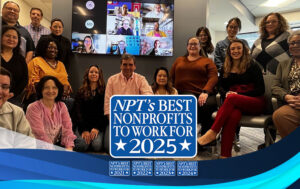John Allen, RingCentral US | September 14, 2020
4 Ways to Foster Great Employee Engagement
Employee engagement is a key part of maintaining a successful business. As reported by America’s Charities, 88 percent of company leaders believe employee engagement programs effectively attract and retain talent, and statistics from Gallup show businesses with high employee engagement have:
- 41% reduction in absenteeism
- 17% increase in productivity
- 24% less turnover in high-turnover organizations
- 59% less turnover in low-turnover organizations
As well as benefits to your business, engagement has direct benefits to your employees. Not only do employees prefer to work for a company whose mission and vision aligns with their own, but engagement opportunities often end up improving employee wellness, reducing burnout, and encouraging personal development. And, whilst employee engagement is at the highest reported rate since 2000, it’s still only at 34 percent. That means around two-thirds of the workforce isn’t engaged with their roles.
What’s more, many organizations are suddenly having to manage more remote teams. Thanks to the COVID-19 pandemic, working from home is increasingly becoming the ‘new normal.’ Keeping employees engaged when they’re not physically present is a significant challenge. It’s even more important, though, when other distractions and worries that could impact productivity are more widespread.
With that in mind, what are the best ways to foster great employee engagement? There are some staple methods that are often recommended. These include encouraging regular breaks, being clear in your goals, and creating a comfortable work environment. But to really excel, you need to go above and beyond – and here are four such methods.
Encourage Flexibility
Despite the global market, many businesses still run on a 9-5 schedule. This can limit how engaged some employees can be. Particularly those with other commitments like children or elderly parents. Encouraging flexible schedules can take some pressure off these employees, and allow them to flourish without the added pressure.

In addition, with the rise of easily accessible technology like voice over IP phone systems and online organization platforms, working from home is a more viable option. Allowing remote work can help employees better manage their work-life balance, reduce commuting time, and encourage location independence.
Lots of businesses traditionally dismissed the idea of working from home. The coronavirus pandemic then caused them to change their thinking. Now, most are finding that the hard-and-fast rules they had really weren’t necessary.
Staff can be engaged and motivated without being on-site. They’ll still deliver top quality work if you give them time in the day to handle family commitments. In fact, showing that kind of flexibility will aid morale, engagement, and productivity.
When most people think of the term ‘flexible working,’ they tend to think of employees having varied hours. However, there are a lot of different styles of work that can be included in this. The more you’re open to, the more options you give your employees. They include:
- Remote working – either standard hours or variable ones
- Partially remote – working from home for some of the job, being in the office at other times
- Condensed workweeks (such as four day weeks with longer hours)
- Part-time
- Job shares – two or more people doing a single role, part-time
- Custom hours – suited to the employee’s individual needs
- Flexitime – some core hours (perhaps 10-2 daily), with the rest arranged around that
- Contingent workers
Being open to adjusting work hours to suit your employees’ needs can help them feel valued and allow them to perform their best. For instance, encouraging a single parent to work partially remotely can reduce childcare costs – not to mention stress levels – and allow the worker to engage with the role more. Allowing a condensed work week means employees who are happy to work longer hours in order to have a longer weekend can take advantage, without losing them to part-time roles. Removing your reliance on standard work hours can help you address individual employee’s needs, leading to better results for both you and them.
Research from the CIPD shows that employees who are allowed to work flexibly have higher satisfaction in their jobs, feel under less pressure, and report a better work-life balance. It also broadens your recruitment process, opening you up to more talented applicants from further afield. The fact flexible working has benefits both for employees and your business makes it a great tactic.
Give Generously
Fostering employee engagement can be done through community engagement. One common method of doing this is matching gift programs – offering to match a set amount of donations to charities from each employee. America’s Charities employee research shows gift matching is one of the top motivators for employees to participate in a program, second only to receiving paid time off for volunteering. According to Cone Communications, more than 50% of workers prefer to work for socially responsible companies, even when the salary is lower.

Of course, just offering matching gifts isn’t enough on its own – you need to make sure your staff are aware of the opportunity and encouraged to participate. It should be easy to participate and understand the process. For example, if you need five separate forms signed by three different people, most people are likely not to bother.
Mentioning your willingness to match employee contributions during training, sending monthly updates on how much has been raised through the matching gifts program, and listing suggested charities on your internal communications platforms can make sure your employees are up to date on this valuable opportunity.
You can also go beyond matching to host a full workplace giving program and encourage employees to engage with your other charitable endeavors. Running online meeting sessions in which employees can submit charities to be voted on for donations, sponsoring particular charities that are personally relevant to employees, or highlighting volunteer programs are all additional ways of fostering a socially responsible environment.
Invest In Technology
Having to do repetitive, mind-numbing tasks is a quick way to reduce employee engagement. By investing in clever technological solutions, you can avoid this – and allow your team members to spend more time on more important aspects of their role! Solutions like contact center software, automated testing, and an inventory management system can all make your staffs’ lives easier.

If you’re not sure where best to invest your tech budget, ask for employee feedback. Find out which aspects of their jobs are the most frustrating or the dullest, and look for solutions to those problems. People are far more likely to be focused on interesting work, so giving them more time to focus on such things is a great way to foster employee engagement.
Some solutions to consider include:
- Internal communication platforms (and allow for off-topic conversations too!)
- Project management systems
- Easy-to-use giving and volunteering platform with reporting and analytics
- Cloud storage and software (vital for remote workers)
- Conferencing technology
- Automation
- Online scheduling and payroll
It’s important to invest in things that will directly impact your employees. Rather than jumping on the latest trends, working from their feedback is the best way to ensure your tech solutions are suited to your team. Another thing that the COVID-19 crisis has taught many businesses is that technology can help them adapt to even the most challenging circumstances.

Provide Ongoing Training
For many companies, training is simply part of the onboarding process and once an employee officially settles into their new role, it’s all finished. However, this should be seen as the bare minimum. A study by PwC showed that for 52% of millennials, opportunities for career progression is something that makes a company compelling to work for, whilst 35% wanted excellent training and development programs.
To really keep your employees satisfied and engaged with their roles, it’s worth investing in continuous training. This can encompass any learning, from mastering the basics of new software – for instance, learning how to share a screen during video calls – or becoming familiar with a new aspect of the business.

Training Courses
E-learning makes providing ongoing training much easier, as you no longer need to physically hold training courses. It also allows employees to study to their own schedules. Of course, providing access to these courses is useless without providing time for them, too. Rather than expecting employees to study in their own time, encourage them to spend a few hours a week working on their continuous development.
You might be tempted to restrict the available options to courses directly relating to their jobs, but this can feel restricting. Especially to those with aspirations of moving into certain departments or roles. Allowing your employees to pursue their educational interests, even if it doesn’t directly impact their job, will help them feel valued and potentially lead to new solutions to existing problems. For example, if someone in your HR department wants to learn about enterprise ecommerce, let them. Not only will they end up more engaged, but they might have new insights they can apply during the recruitment process.
Mentorship
As well as providing training courses, you should consider having a strong mentorship program. Whilst e-learning can teach theory, there’s a lot of things you only learn from having worked in the field – and mentorship can help pass these on. Encouraging senior employees to work with junior workers can level the playing field a bit, breaking down artificial barriers between team members.
By having a connected workforce, mentorships no longer rely on being in the same physical location. Having contacts at other offices can help employees understand the business on a larger scale. Having a more in-depth understanding, too, leads to higher engagement, as they can see the ‘big picture’ rather than a single role.
Mentorship should provide insights that can’t be learned elsewhere, and it’s not suited for everyone. It’s important to choose the right combinations of people, so if you’re going to implement a mentorship scheme you’ll need to invest in it. You don’t want to make it mandatory, but you do want to encourage it, so make sure there are benefits to the mentors, too!
About the author: John Allen, Director, Global SEO at RingCentral, a global UCaaS, and VoIP Phone Service provider. He has over 14 years of experience and an extensive background in building and optimizing digital marketing programs. He has written for websites such as Recruitee and WebsitePulse.
Cover image source: Unsplash

Get Resources and Insights Straight To Your Inbox
Explore More Articles
Make the Holidays More Meaningful: Engage Your Team with Employee Giving Technology
The holiday season is a time for connection, gratitude, and giving back. For employers, it’s also an ideal moment to strengthen workplace culture, deepen employee…
Read ArticleLaunch a Turnkey Holiday Giving Campaign
Sign up by October 3, 2025 to launch your employee donation site in time for the holidays! Give employees a simple, meaningful way to make…
Read ArticleData Processor & Customer Service Representative, Charitable Funds Management Solutions
Reporting Structure: Director, CFMS Term: October 2025 to February 2026 Schedule: Full-Time; Monday-Friday up to 37.5 hours per week. Rate: $20 per hour Overview of…
Read ArticleGet Resources and Insights Straight To Your Inbox
Receive our monthly/bi-monthly newsletter filled with information about causes, nonprofit impact, and topics important for corporate social responsibility and employee engagement professionals, including disaster response, workplace giving, matching gifts, employee assistance funds, volunteering, scholarship award program management, grantmaking, and other philanthropic initiatives.




